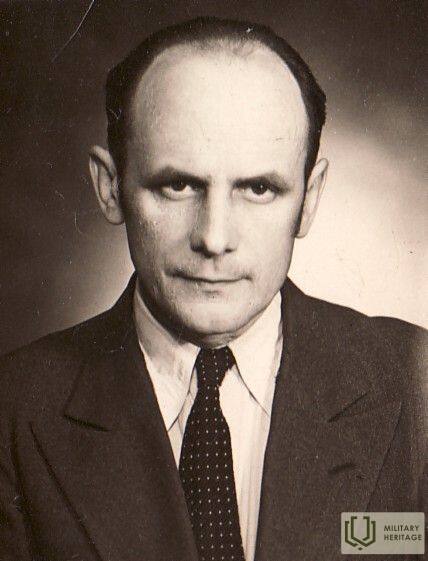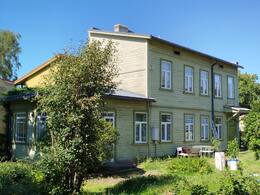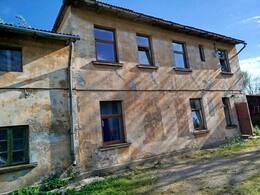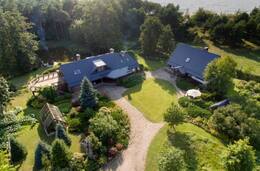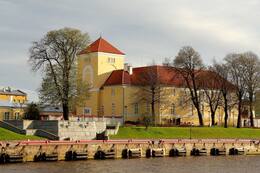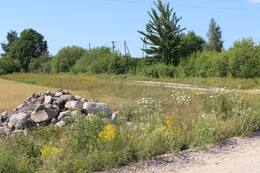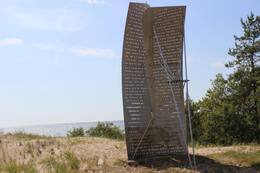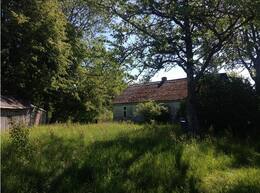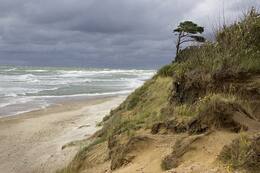Die geheimen und gefährlichen Aktivitäten von Valdemārs Ģinters
Valdemārs Ģinters' Name war für viele lettische Flüchtlinge die letzte Hoffnung auf die Flucht nach Schweden. Zu viel Aufmerksamkeit vonseiten der Flüchtlinge war gefährlich, und deshalb hielt Ģinters ihn geheim.
Die Tatsache, dass der „schwedische Fall“ von V. Ģinters, genannt Dakters, geleitet wurde, war inzwischen öffentlich bekannt. Damals war es schwierig, einen Flüchtigen aufzuspüren, da sich Flüchtlinge – anders als in Lettland üblich – nicht bei der Polizei meldeten. Sie konnten auch einen anderen Namen annehmen. Bekanntschaften wurden in dieser Phase meist entweder auf die übliche Weise geknüpft, indem man seinen Namen nannte, oder unverständlich und undeutlich. V. Ģinters hatte es nicht leicht, die Verfolger loszuwerden. Sie hatten ihn in seiner Wohnung in der Karlīnes-Straße 4 aufgespürt, und als man ihnen den Zutritt verweigerte, gingen sie die Straße entlang und warteten auf ihn. Ģinters musste über den Zaun fliehen und einen anderen Ausgang auf die Straße finden.
Jenseits des Meeres 1944/45. Die Erinnerungen von 130 Zeugen wurden von V. Lasmane zusammengestellt. Stockholm: Memento, 1990, S. 80–81.
Zugehörige Zeitleiste
Zugehörige Themen
Zugehörige Objekte
Das Gebäude in Ventspils, in dem Dr. Valdemārs Ģinters, ein Vertreter der lettischen Kommunistischen Partei und Organisator des Flüchtlingsbootverkehrs in Kurzeme, in den Jahren 1944-1945 lebte.
Das Haus in der Katrīnes-Straße 4, Ventspils, in dem der Archäologe Valdemārs Ģinters arbeitete.
Von Oktober 1944 bis zum 8. Mai 1945 war der Archäologe Valdemārs Ģinters (Spitznamen „Doktor“, „Gärtner“) (1899–1979) Vertreter der Lettischen Kommunistischen Partei Lettlands (LCP) in Kurzeme. Er nahm am Lettischen Unabhängigkeitskrieg teil, war Direktor des Staatlichen Historischen Museums und Dozent an der Universität Lettlands. Ihm wurden der Lāčplēsis-Kriegsorden und der Drei-Sterne-Orden verliehen. Er war einer der Unterzeichner des LCP-Memorandums vom 17. März 1944. Nach dem Zweiten Weltkrieg lebte er in Schweden. Von 1949 bis 1979 war er Vorsitzender des Vorstands der Lettischen Nationalstiftung.
Das Gebäude in Ventspils, in dem der LCP-Verbindungsmann Valentine Jaunzeme (Lasmane) im Jahr 1944 wohnte.
Das Haus in der Lauku-Straße 4 in Ventspils war das Zuhause der Lehrerin Valentīne Lasmane (geb. Jaunzeme) (1916–2018). Sie war Verbindungsoffizierin der Lettischen Kommunistischen Partei und Mitglied der Verbindungsgruppe Ventspils. Nach dem Zweiten Weltkrieg lebte sie in Schweden.
Sie trug die Zeugnisse von 130 Bootsflüchtlingen in der Publikation „Über das Meer 1944/1945“ (Stockholm, 1990) zusammen, doch V. Lasmanes eigene Lebensgeschichte kann in dem Buch „Die Nacht ist nicht länger nur zum Schlafen da“ (Riga, 2020) nachgelesen werden. Im Jahr 2000 wurde ihr der Drei-Sterne-Orden verliehen. Sie starb 2018 im Alter von 102 Jahren im Stockholmer Vorort Täby.
„Bambaļi“-Häuser – eine der wichtigsten Unterkünfte für Bootsflüchtlinge
Die restaurierten „Bambaļi“-Häuser in Ošvalki, Gemeinde Jūrkalne, die 1944 einer der wichtigsten Unterbringungsorte für Bootsflüchtlinge an der Küste Kurlandes waren.
Erinnerungen des Bootsflüchtlings Kārlis Draviņš: „Die „Bambaļi“ waren alte, kleine, sehr heruntergekommene Häuser in der Gemeinde Jūrkalne, etwa 40 Kilometer von Ventspils entfernt. […] Kleine Felder erstreckten sich in einem feuchten Gebiet, doch auf der anderen Seite schmiegte sich eine alte, überwucherte Düne darum. Dahinter gurgelte das Meer – die Häuser lagen direkt am Wasser. Auf der anderen Seite, einen halben Kilometer entfernt, verlief die Straße Pāvilosta-Užava, aber der Weg zu den Häusern war schwer befahrbar, weshalb die Deutschen hier nicht regelmäßig zu Gast sein konnten. Der Warteplatz für die Boote war leicht zugänglich – eine kleine Waldlichtung an einem hohen Ufer. […]“
Die Besitzerin von „Bambaļi“ und ihre Gruppe, die ebenfalls auf die „Bewegung des Wassers“ warteten, lebten in zwei Zimmern mit Meerblick. Die Flüchtlingsgruppe hingegen wohnte am anderen Ende des Hauses, ebenfalls in zwei Zimmern. Sie teilten sich die Küche. Der Flur zwischen den beiden Enden war vollgestopft mit den Habseligkeiten der Flüchtlinge. Die Zimmer waren mit Stroh ausgekleidet, das an den Wänden entlang verstreut war. Auf jeder Seite des Zimmers stand ein Bett, in dem eine Mutter mit ihren Kindern schlief. Tagsüber wurden die Strohbetten mit Laken oder Ähnlichem abgedeckt. Sie kamen heraus, um darauf zu sitzen oder zu schlafen, da es keine andere Unterkunft gab. […] Die Tage vergingen eintönig, einer nach dem anderen. Sie standen auf Kommando auf, ohne Eile. Nach dem gemeinsamen Frühstück spielten einige Karten, andere versuchten sich in der Wahrsagerei, wieder andere im Lesen. Manche mussten Hausarbeiten erledigen – Holz und Wasser holen.
Die Küste von Mazirbe, von wo aus 1944 der Flüchtlingsbootverkehr nach Schweden stattfand.
Die Küste von Mazirbe war während des Zweiten Weltkriegs ein wichtiger Ort, von dem aus 1944 Flüchtlingsboote nach Schweden gelangten.
Erinnerungen der Bootsflüchtling Ilona Cīrule (geb. Mālītis): „Ich war damals 13 Jahre alt. Ich erinnere mich, dass wir Ende September eine ganze Woche lang in einem Wohnwagen von Riga nach Mazirbe reisten. Die Reise ist mir als etwas Unangenehmes in Erinnerung geblieben: Die russischen Kerzen am Himmel beunruhigten mich zutiefst. Wir lebten etwa drei Wochen in Mazirbe, und jeden Tag hörte ich Gespräche über die Überfahrt und die Suche nach Booten. Schließlich, am 21. Oktober, mussten wir uns bereit machen. […] Wir waren etwa 90 Personen auf dem Boot. Ich saß auf dem Schoß meines Vaters an Deck. Die kleinen Kinder mit ihren Müttern waren unten und bekamen kaum Luft. Ich muss wohl eingenickt sein, aber am Morgen des nächsten Tages wurde ein Flugzeug gesichtet und ein Schiff am Horizont. Da wurde es still. Am Nachmittag kam das Schiff wieder, und diesmal kam es direkt auf uns zu. Aber es geschah wie im Märchen: Es war ein schwedisches Kriegsschiff! Sie zogen uns alle an Bord.“ Das Schiff gab uns warmen Kakao und brachte uns zum Hafen von Nynäshamn. Unser Boot wurde dort festgemacht und von seinem Besitzer, Zariņš-Petravs, wohlbehalten in Empfang genommen. Unter den Gästen waren Šici, Zanderi, Vanagi, die ehemalige Justizministerin Frau Apsīša, unsere Familie und andere. Ich weiß, dass das Boot mit Gold bezahlt werden musste. Aber wie viel – das weiß ich nicht.
Gefängnis in der Burg des Livländischen Ordens während des Zweiten Weltkriegs
Mehrere Mitglieder der Kommunikationsgruppe LCP Ventspils und Flüchtlingsbootsbetreiber wurden 1944-1945 in dem im Schloss des Livländischen Ordens eingerichteten Gefängnis inhaftiert.
Erinnerungen des Bootsmanns Žanis Fonzovs: „Zwei Boote verließen Schweden – die „Krīvs“ und die „Zvejnieks“. Ich war auf der „Zvejnieks“, und zur Besatzung gehörten Saulīte und Grunti. […] Das Wetter war herrlich, ich segelte so unauffällig, nicht sehr hoch. Ich sah es sofort – ich war im Morsecode. Das Boot näherte sich. Ich ging hinunter in den Maschinenraum, denn neben Saulītes Papieren hatte ich auch Briefe von den Ankünften an Verwandte in Lettland und die gesammelten Waffen in einer Tasche. Ich warf die Briefe und Papiere in diese Waffentasche und alles über Bord. Was dann! Das Boot näherte sich unserem, und die Deutschen verlangten unsere Führerscheine. […] So brachten uns die Deutschen am 21. Oktober mit der gesamten „Zvejnieks“ nach Ventspils. Sie brachten uns ins Gefängnis. Es waren etwa 30 Leute in dem Raum. Ich trug einen Schaffellmantel.“ Zurück auf dem Boden legte ich es mir über, aber ich hatte die Nacht nicht geschlafen. Am zweiten oder dritten Tag wurden wir zum Verhör vorgeladen. Wir hatten vereinbart, zu sagen, dass wir Flüchtlinge auf dem Weg nach Deutschland seien. Ich wollte nur nach Lielirbe, um meinem Freund zu folgen. Anscheinend glaubten sie uns damals. […] Doch dann änderte sich die Lage in Ventspils: Die Stadt wurde von der Militärverwaltung übernommen, und wir wurden ein zweites Mal verhört. Es war schlimmer, denn sie zeigten uns eine Schachtel schwedischer Streichhölzer und eine Krone, die angeblich auf dem Boot gefunden worden waren. Einer der Vernehmer war Lette, und er enthauptete uns sogar, weil wir die ganze Wahrheit gesagt hatten. Wir sahen ein, dass das Märchen vorbei war; wir mussten einfach gestehen.
Der Weg zum Haus "Grīnieki" in der Gemeinde Vārve
Die Straße zu den Häusern „Grīnieki“ in der Gemeinde Vārve, wo sich 1944 eine der wichtigsten Siedlungen für Bootsflüchtlinge an der Küste Kurlandes befand.
Erinnerungen des Bootsmanns V. Jurjakas: „Als ich den Hof von „Grīnieki“ betrat, wirkte alles ganz normal. Ein ruhiges Landhaus, keine Menschenseele, wahrscheinlich nur Leute in der Sonne. […] Es stellte sich heraus, dass nicht nur das Wohnhaus von „Grīnieki“ voll belegt war, sondern alle Gebäude. Die Scheune, der Getreidespeicher, der Heuboden und das Badehaus. Ich traf ein paar Bekannte, denn es war Zeit, unser Land zu verlassen. […] Die Ernährungslage war nicht kritisch, aber doch recht schlecht. […] Am Abend setzte sich der Flüchtlingstreck in Richtung Küste in Bewegung. Ich hatte alle im Voraus gewarnt, nicht aus dem Gebüsch am Strand herauszukommen, da sich dort Unterstände und Beobachtungsposten der Küstenwache befanden. Es war ein großer Treck, denn etwa 200 Menschen wollten ans Meer. Es bestand keine Hoffnung, dass alle rechtzeitig ankommen würden. Der Abend war noch nicht sehr dunkel, und ich konnte die Aktivitäten der gesamten Gruppe beobachten. Am auffälligsten waren die großen „Als die Menschen noch lebten“-Konvois.“ In „Grīnieki“ hatten sie sie nicht gesehen, doch jetzt, im Licht der Öffentlichkeit, sahen sie nur noch dies. Allein die Waren benötigten ein ganzes Boot. Drei bis vier zweispännige Wagen waren mit Waren beladen, gefolgt von den Menschen. […] Wir warteten lange auf das Boot, aber es kam nicht. Die ganze Karawane musste umkehren. Es war stockdunkel.
Temporäre Flüchtlingsunterkünfte „Vārves būda“
"Vārves būdas", ein Ort in der Gemeinde Ventspils, der 1944 als vorübergehende Unterkunft für lettische Flüchtlinge diente, die auf die Ankunft von Booten aus Gotland warteten.
Erinnerungen des Bootsmanns V. Jurjaks:
Mein Halbbruder und seine Familie waren aus Riga zu uns gekommen, und als die Nachricht kam, dass in Vārve ein Schiff erwartet wurde, schloss ich mich mit der Gruppe um Polizeichef Jasūnas zusammen, und wir machten uns alle auf den Weg nach Vārve. Wir warteten bis spät in die Nacht auf Signale, aber das Schiff kam nicht. So warteten wir eine ganze Woche. Es begann zu regnen. Die Leute bauten Zelte aus Laken, deshalb nannten wir diesen Ort „Vārve-Hütten“. Meine Frau und ich verbrachten tagsüber mehr Zeit in Ventspils, und schließlich mussten wir uns überlegen, wie wir die Wartenden mit Essen versorgen konnten. Ich erinnere mich an eine Nacht, als meine Frau und ich ihnen auf unseren Fahrrädern heiße, gekochte Kartoffeln durch den Wald brachten. Es regnete in Strömen, Blitze zuckten, und die warmen Kartoffeln schmeckten den Wartenden, die sich aus dem Wald gedrängt hatten, gut. Der Förster von Vārve hatte dieses Versteck zufällig entdeckt, aber – nachdem ich ihm eine Versetzung in Aussicht gestellt hatte – kam er, um zu helfen. Die Deutschen hatten begonnen, durch das Gebiet zu gehen. Die Häuser der Küstenbewohner wurden durchsucht, um Menschen aus den Jahren der Wehrpflicht zu finden. Zwei junge Leute waren im Wald nahe der „Vārve-Hütten“ aufgegriffen worden. Daher konnte dieser Ort für die über fünfzig Menschen, die hier ausharrten, nicht mehr sicher sein.
Gedenkschild für Flüchtlinge "Segel der Hoffnung" in Jūrkalne
Das "Sail of Hope"-Gedenkschild für die Flüchtlinge des Zweiten Weltkriegs, die 1944 und 1945 mit dem Boot über die Ostsee auf die schwedische Insel Gotland kamen. Das Denkmal befindet sich in Osvalki auf den Dünen zwischen dem Meer und der Autobahn Ventspils-Liepaja, in der Nähe der Haltestelle "Kaijas". Es wurde von dem Bildhauer Ģirts Burvis geschaffen, der es als ein Segel der Hoffnung, das die Erinnerung an die lettischen Flüchtlinge symbolisiert, realisiert hat.
Zwischen Herbst 1944 und Frühjahr 1945 versuchten einige lettische Bürger, die die erneute sowjetische Besatzung fürchteten, aber nicht bereit waren, in das zerstörte und bedrohte Deutschland zu fliehen, das nächstgelegene neutrale Land, Schweden, auf dem Seeweg zu erreichen. Einige der Boote wurden vom lettischen Zentralrat mit Hilfe der westlichen Alliierten organisiert, was zu einer der größten Flüchtlingskonzentrationen in der Gemeinde Jūrkalnes führte. Neben den vom lettischen Zentralrat organisierten Booten wurden auch andere Boote über das Meer gebracht. Es wird geschätzt, dass etwa 5000 Personen die Überfahrt geschafft haben. Die Zahl der Todesopfer ist unbekannt, da keine Aufzeichnungen über die Flüchtlinge geführt wurden, die die Küste von Kurzeme verließen.
Die Überfahrten waren gefährlich, da die Flüchtlinge durch deutsche Patrouillen an der Küste und auf See, Seeminen, sowjetische Flugzeuge und Kriegsschiffe sowie Stürme bedroht waren, da die Überfahrten oft in ungeeigneten und überladenen Kuttern und Booten ohne ausreichende Treibstoff- und Lebensmittelvorräte, Seekarten und Navigationsinstrumente stattfanden. Die Abfahrten von Lettland aus erfolgten im Geheimen. Das Ziel der Boote war die Insel Gotland, und die Fahrten begannen meist an der Westküste Kurlands (von Jūrkalne nach Gotland sind es 90 Seemeilen oder etwa 170 Kilometer Luftlinie).
„Laukgaļi“-Häuser, die Residenz des Schriftstellers Kārlis Skalbe
„Laukgaļi“ in der Gemeinde Jūrkalne, der Ort, an dem sich der Schriftsteller Kārlis Skalbe im Oktober/November 1944 aufhielt, während er auf ein Flüchtlingsboot nach Schweden wartete.
Der Schriftsteller Kārlis Skalbe (1879–1945) war Mitglied des Lettischen Provisorischen Nationalrats und des Lettischen Volksrats, Abgeordneter der Verfassungsgebenden Versammlung der Republik Lettland sowie der 1. und 4. Saeima. Während der deutschen Besatzung war er Chefredakteur der Literaturzeitschrift „Latvju Mēnešraksts“ und einer der Unterzeichner des Memorandums der Lettischen Kommunistischen Partei Lettlands vom 17. März 1944.
Am 11. November 1944 floh sie nach Schweden. Sie starb 1945 in Stockholm.
Das steile Ufer von Staldzene, von dem aus 1944 der Flüchtlingsbootverkehr nach Schweden stattfand.
Im Jahr 1944 gab es einen regen Flüchtlingsbootverkehr von den Klippen von Staldzene zu den Küsten Schwedens.
Ž. Lapuķis' Erinnerungen an die Begegnung mit Dr. E. Bakusis:
„Eines Nachmittags kam ein örtlicher Polizist zu mir und teilte mir leise mit, dass in der Nacht in der Nähe des Dorfes Staldzene am Koku-Gebirge ein Boot aus Schweden erwartet würde, um Flüchtlinge aufzunehmen. Meine Aufgabe war es, mit einer Gruppe von Wachleuten meiner Einheit dorthin zu kommen, um den Ort zu bewachen und gegebenenfalls beim Transport der Flüchtlinge zum Motorboot zu helfen. […] Nicht weit vom Meer entfernt stand plötzlich ein Mann vor uns auf dem Seil. Er trug einen grauen Halbmantel mit hochgeschlagenem Kragen und eine tief ins Gesicht gezogene Jockeymütze. Er sagte leise „Guten Abend“ und fragte: „Ist das der Weg nach Lošupi?“ Das war das Motto der schwedischen Reiter dort. Er sagte, er sei in einer besonderen Mission hier, wolle aber gleichzeitig seine Familie sicher nach Schweden bringen. Dann, zu meiner großen Überraschung, zog er unseren Forstplan aus der Tasche. In der Dämmerung begann ich, das Gesicht des Fremden zu beobachten und erkannte ihn bald. Es war Bakūzis, der Leiter der Forstwirtschaftsabteilung. […] Es näherte sich Mitternacht, als wir in der Ferne einen schwarzen Punkt auf dem Meer sahen. Wir gaben das vereinbarte Signal mit einer Taschenlampe und wiederholten es mehrmals. Nach kurzer Zeit kam dieselbe Antwort von dem schwarzen Punkt, nur dass es nicht von einer Taschenlampe kam, sondern vom Lichtstrahl eines Kriegsschiffs. Uns wurde klar, dass das Boot in dieser Nacht nicht mehr erwartet wurde und sich die Flüchtlingsgruppe auflöste. Bakūzis lud uns beide und den Kompaniechef ein, bei seiner Familie zu übernachten. Wir fanden sie in einer Mulde in den Dünen unter einer dichten Tanne. Dort, im grünen Moos, mit ihren Köpfen Auf einem weißen Kissen lagen die drei Kinder der Familie tief schlafend, neben ihnen saß die fürsorgliche Mutter mit einem weißen Kopftuch. Der Vater hatte eine Flasche geholt, und die Mutter bot ihnen belegte Brote an. Mit ihrer lettischen Herzlichkeit schienen sie die wahren Eltern des Hauses zu sein, die in dieser regnerischen Herbstnacht unter der Tanne ihrer Heimat ihr Zuhause gefunden hatten. Auf der einen Seite rauschte das Meer, auf der anderen erhob sich ein Waldmassiv, und schwere Regentropfen fielen langsam durch die Zweige der Tanne. Wir leerten die Flasche, lehnten aber die Brote ab, denn wir wussten, dass sie sie selbst dringender brauchten.




